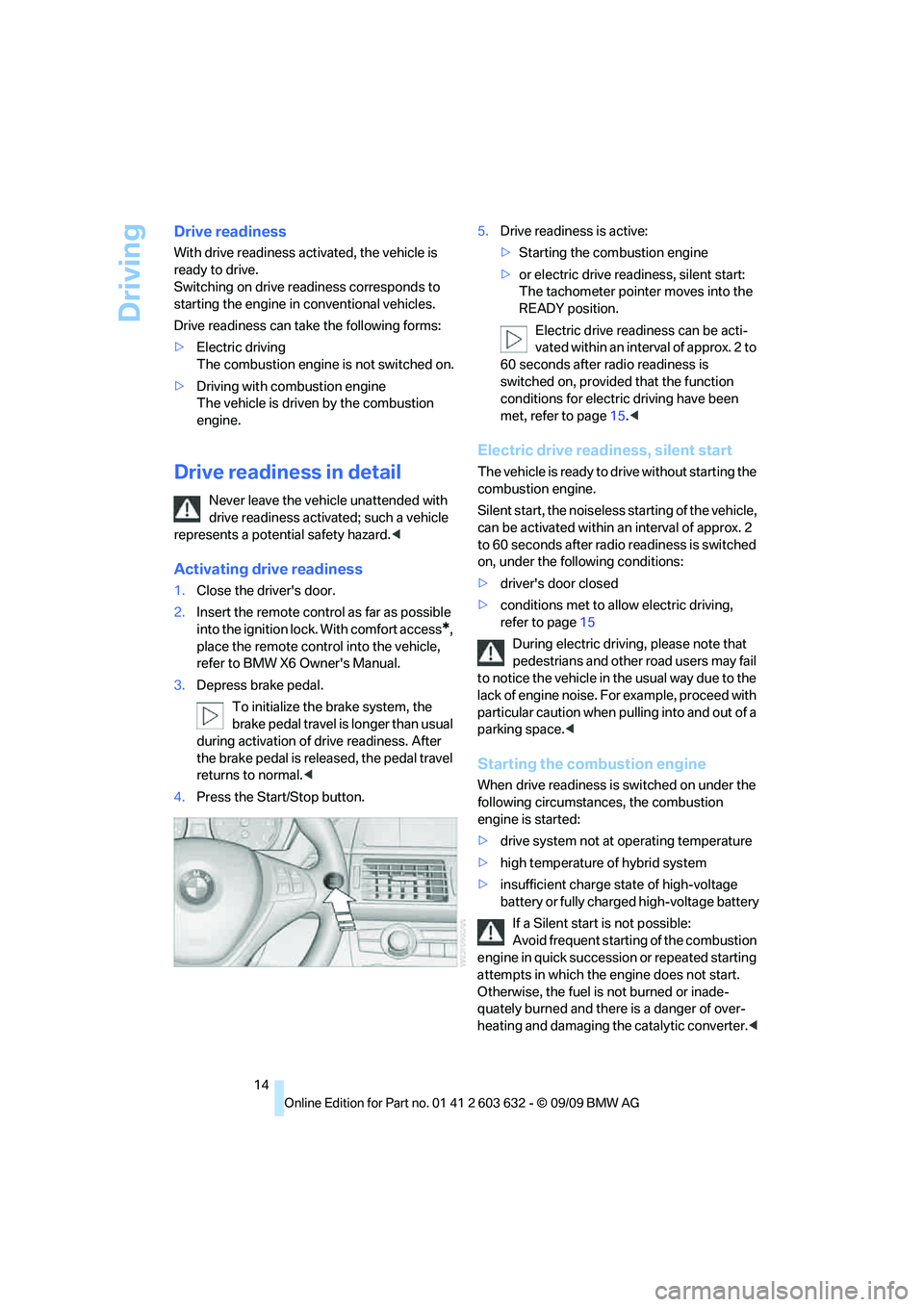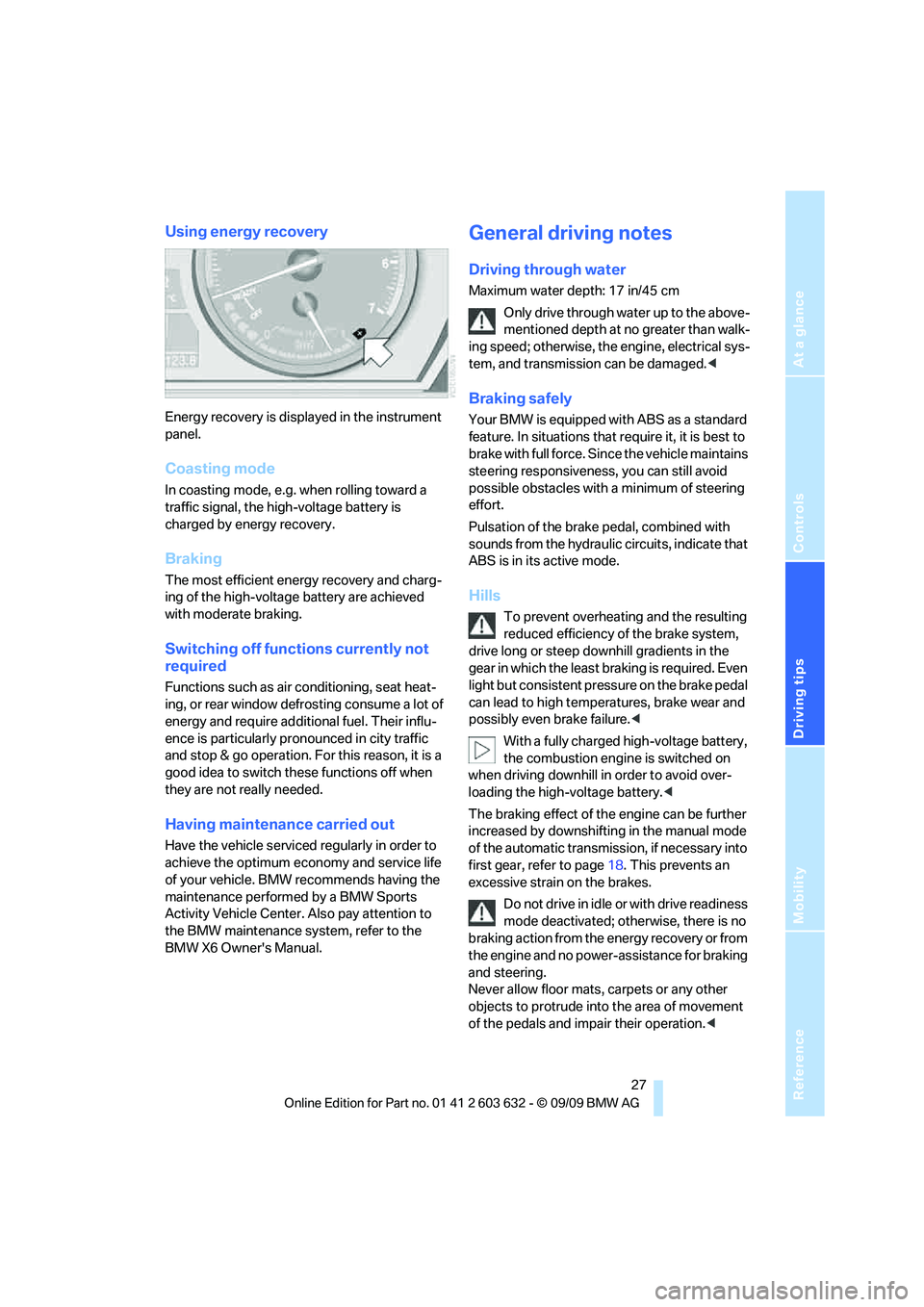heating BMW ACTIVEHYBRID X6 2010 Owners Manual
[x] Cancel search | Manufacturer: BMW, Model Year: 2010, Model line: ACTIVEHYBRID X6, Model: BMW ACTIVEHYBRID X6 2010Pages: 54, PDF Size: 3.16 MB
Page 16 of 54

Driving
14
Drive readiness
With drive readiness activated, the vehicle is
ready to drive.
Switching on drive readiness corresponds to
starting the engine in conventional vehicles.
Drive readiness can take the following forms:
>Electric driving
The combustion engine is not switched on.
>Driving with combustion engine
The vehicle is driven by the combustion
engine.
Drive readiness in detail
Never leave the vehicle unattended with
drive readiness activated; such a vehicle
represents a potential safety hazard.<
Activating drive readiness
1.Close the driver's door.
2.Insert the remote control as far as possible
into the ignition lock. With comfort access
*,
place the remote control into the vehicle,
refer to BMW X6 Owner's Manual.
3.Depress brake pedal.
To initialize the brake system, the
brake pedal travel is longer than usual
during activation of drive readiness. After
the brake pedal is released, the pedal travel
returns to normal.<
4.Press the Start/Stop button.5.Drive readiness is active:
>Starting the combustion engine
>or electric drive readiness, silent start:
The tachometer pointer moves into the
READY position.
Electric drive readiness can be acti-
vated within an interval of approx. 2 to
60 seconds after radio readiness is
switched on, provided that the function
conditions for electric driving have been
met, refer to page15.<
Electric drive readiness, silent start
The vehicle is ready to drive without starting the
combustion engine.
Silent start, the noiseless starting of the vehicle,
can be activated within an interval of approx. 2
to 60 seconds after radio readiness is switched
on, under the following conditions:
>driver's door closed
>conditions met to allow electric driving,
refer to page15
During electric driving, please note that
pedestrians and other road users may fail
to notice the vehicle in the usual way due to the
lack of engine noise. For example, proceed with
particular caution when pulling into and out of a
parking space.<
Starting the combustion engine
When drive readiness is switched on under the
following circumstances, the combustion
engine is started:
>drive system not at operating temperature
>high temperature of hybrid system
>insufficient charge state of high-voltage
battery or fully charged high-voltage battery
If a Silent start is not possible:
Avoid frequent starting of the combustion
engine in quick succession or repeated starting
attempts in which the engine does not start.
Otherwise, the fuel is not burned or inade-
quately burned and there is a danger of over-
heating and damaging the catalytic converter.<
Page 18 of 54

Driving
16
Possible range
The vehicle can travel approx. 1.5 miles/2.5 km
under electric power.
Driving with combustion engine: DRIVE
The combustion engine supplies the drive out-
put for moving the vehicle. The high-voltage
battery is charged at the same time.
Automatic starting while driving
Under the following circumstances, the com-
bustion engine is started automatically while
driving:
>transmission position M/S selected
>driving speed greater than 40 mph/65 km/h
>low charge state or fully charged high-volt-
age battery, e.g. when driving downhill
>to protect the high-voltage system from
overheating, e.g. when driving downhill
>high output request, e.g. by accelerator
pedal position.
Automatic switching off while driving
When decelerating under the conditions for
electric driving, refer to page15, the combus-
tion engine is switched off.
Assisted combustion engine
The combustion engine supplies the main drive
output for moving the vehicle.
The electric motors assist by providing addi-
tional drive output as needed.
eBOOST
When accelerating quickly, e.g. when passing
another vehicle, power from the two electric
motors simultaneously is requested in addition
to that of the combustion engine. To trigger
this, step down hard on the accelerator pedal.
Display in the instrument panel, refer to
page22.
Energy recovery: CHARGE
The hybrid system makes it possible to convert
kinetic energy into electrical current, e.g. during braking. This energy recovery is used to charge
the high-voltage battery. The battery supplies
this stored energy back to the electric motors
as needed.
To recover the braking energy, the following
conditions must be met:
>The vehicle is in motion.
>The selector lever is in the position D, R, or
M/S.
>The high-voltage battery is not completely
charged.
Display of energy recovery in the instrument
panel, refer to page22
Two-Mode Active
Transmission with Steptronic
The Das Two-Mode Active Transmission is an
automatic transmission in which the gears can
be shifted in a fully automatic fashion or can be
shifted manually on demand. The manual shift-
ing is performed using the selector lever or the
shifting paddles of the Steptronic, refer to
page18.
Automatic shifting may be perceptible
when decelerating at a low speed.<
Transmission positions
P R N D M/S + –
Hold the brake pedal down until starting
to drive; otherwise, the vehicle can begin
to roll.<
Displays in instrument panel
P R N D, S1 through S7, M1 through M7
Page 29 of 54

Reference
At a glance
Controls
Driving tips
Mobility
27
Using energy recovery
Energy recovery is displayed in the instrument
panel.
Coasting mode
In coasting mode, e.g. when rolling toward a
traffic signal, the high-voltage battery is
charged by energy recovery.
Braking
The most efficient energy recovery and charg-
ing of the high-voltage battery are achieved
with moderate braking.
Switching off functions currently not
required
Functions such as air conditioning, seat heat-
ing, or rear window defrosting consume a lot of
energy and require additional fuel. Their influ-
ence is particularly pronounced in city traffic
and stop & go operation. For this reason, it is a
good idea to switch these functions off when
they are not really needed.
Having maintenance carried out
Have the vehicle serviced regularly in order to
achieve the optimum economy and service life
of your vehicle. BMW recommends having the
maintenance performed by a BMW Sports
Activity Vehicle Center. Also pay attention to
the BMW maintenance system, refer to the
BMW X6 Owner's Manual.
General driving notes
Driving through water
Maximum water depth: 17 in/45 cm
Only drive through water up to the above-
mentioned depth at no greater than walk-
ing speed; otherwise, the engine, electrical sys-
tem, and transmission can be damaged.<
Braking safely
Your BMW is equipped with ABS as a standard
feature. In situations that require it, it is best to
brake with full force. Since the vehicle maintains
steering responsiveness, you can still avoid
possible obstacles with a minimum of steering
effort.
Pulsation of the brake pedal, combined with
sounds from the hydraulic circuits, indicate that
ABS is in its active mode.
Hills
To prevent overheating and the resulting
reduced efficiency of the brake system,
drive long or steep downhill gradients in the
gear in which the least braking is required. Even
light but consistent pressure on the brake pedal
can lead to high temperatures, brake wear and
possibly even brake failure.<
With a fully charged high-voltage battery,
the combustion engine is switched on
when driving downhill in order to avoid over-
loading the high-voltage battery.<
The braking effect of the engine can be further
increased by downshifting in the manual mode
of the automatic transmission, if necessary into
first gear, refer to page18. This prevents an
excessive strain on the brakes.
Do not drive in idle or with drive readiness
mode deactivated; otherwise, there is no
braking action from the energy recovery or from
the engine and no power-assistance for braking
and steering.
Never allow floor mats, carpets or any other
objects to protrude into the area of movement
of the pedals and impair their operation.<